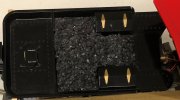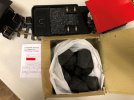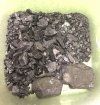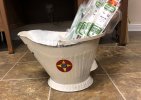David Palmeter
Fun in the Central Hoosier Flatlands
Disclosure - I am not a live steam modeler, I am electron-flow dependent.
However, I thought I would bring a related question to the experts. Several years ago, a friend shared his small supply of crushed coal with me for my 1:24 scale vintage Kalamazoo 4-4-0 upgrade project (first picture). He no longer has any coal available so, as a member of the Chesapeake & Ohio Historical Society, I convinced the C&OHS Heritage Center to send me some actual coal from the locomotives they have at the Center (second picture).
My problem is breaking the very hard (Anthracite?) lumps of coal into the sizes shown in the 4-4-0. Hitting the lumps with a hammer makes a mess and yields a variety of sizes, many too small for use. Putting the coal in a sack and hitting it destroys the sack. Is there a secret to getting uniform pieces and avoiding scattering coal everywhere?
Thanks for any comments or suggestions,
David



However, I thought I would bring a related question to the experts. Several years ago, a friend shared his small supply of crushed coal with me for my 1:24 scale vintage Kalamazoo 4-4-0 upgrade project (first picture). He no longer has any coal available so, as a member of the Chesapeake & Ohio Historical Society, I convinced the C&OHS Heritage Center to send me some actual coal from the locomotives they have at the Center (second picture).
My problem is breaking the very hard (Anthracite?) lumps of coal into the sizes shown in the 4-4-0. Hitting the lumps with a hammer makes a mess and yields a variety of sizes, many too small for use. Putting the coal in a sack and hitting it destroys the sack. Is there a secret to getting uniform pieces and avoiding scattering coal everywhere?
Thanks for any comments or suggestions,
David






